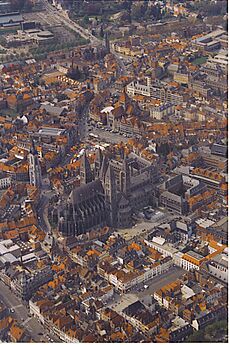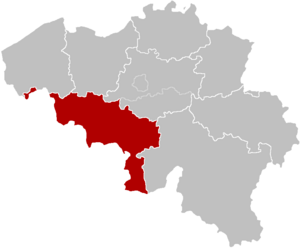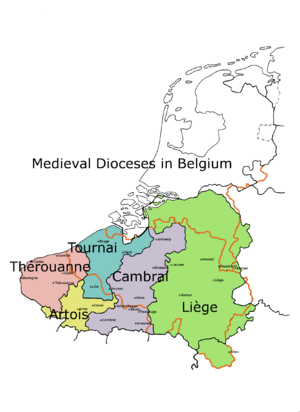Roman Catholic Diocese of Tournai facts for kids
Quick facts for kids Diocese of TournaiDioecesis Tornacensis Diocèse de Tournai (French) Bistum Tournai (German) Bisdom Doornik (Dutch) |
|
|---|---|

Aerial view of Tournai Cathedral
|
|
| Location | |
| Country | Belgium |
| Ecclesiastical province | Mechelen-Brussels |
| Metropolitan | Archdiocese of Mechelen-Brussels |
| Coordinates | 50°36′26″N 3°23′18″E / 50.607195°N 3.388198°E |
| Statistics | |
| Area | 3,796 km2 (1,466 sq mi) |
| Population - Total - Catholics |
(as of 2020) 1,344,241 708,400 (52.7%) |
| Information | |
| Denomination | Catholic Church |
| Rite | Roman Rite |
| Established | 6th Century |
| Cathedral | Cathedral of Our Lady in Tournai |
| Current leadership | |
| Pope | Francis |
| Bishop | Guy Harpigny |
| Metropolitan Archbishop | Jozef De Kesel |
| Map | |
 The Diocese of Tournai, coextensive with the province of Hainaut |
|
| Website | |
| Website of the Diocese | |
The Diocese of Tournai is an important area for the Catholic Church in Belgium. It is also known by its Latin name, Dioecesis Tornacensis. This diocese was created in 1146. Before that, it was part of the Diocese of Noyon and Tournai since the 600s.
Today, the Diocese of Tournai is connected to the Archdiocese of Mechelen–Brussels. The main church of the diocese is the Cathedral of Notre-Dame de Tournai. This cathedral is a very special building. It has been recognized as an important part of Wallonia's history since 1936. It also became a World Heritage Site in 2000, meaning it's important to the whole world.
Contents
History of the Diocese
Early Beginnings
The story of the Diocese of Tournai goes way back to the 200s. A person named St. Piat shared Christian teachings in Tournai around that time. Some people say he was the first bishop, but we don't have clear proof. Sadly, St. Piat was killed during a time when Christians were being persecuted.
After this, there were many Barbarian invasions from the late 200s to the late 400s. Later, St. Remigius helped organize the Catholic Church in northern Gaul. Around the year 500, he started the See of Tournai. He chose Eleutherius to be its first bishop.
Tournai was once a royal city, which helped it become important early on. However, it lost its status as a capital city when the Merovingian court moved away. Even so, Tournai kept its own bishops for almost 100 years.
Joining with Noyon
Around 626 or 627, under Bishop St. Achar, the areas of Tournai and Noyon were joined together. They still kept their separate ways of working, but they shared the same bishop. Tournai lost some of its special rights and became similar to nearby dioceses. This shared leadership lasted for 500 years. It wasn't until 1146 that Tournai got its own bishop again.
Notable Bishops Through Time
Many important bishops have led the Diocese of Tournai over the centuries.
- St. Eleutherius was the first bishop in the early 500s.
- St. Achar was bishop from 626/27 to 637/38.
- St. Eloi served from 641 to 660.
- Walter de Marvis (1219–1251) was known for starting many schools and hospitals.
- Etienne of Tournai (1192–1203) was a godfather to a French king.
- Guillaume Fillastre (1460–1473) was an important leader of the Golden Fleece.
- Michel d'Esne (1597–1614) wrote several books.
- Raphael de Mercatellis (1487–1507) was an auxiliary bishop and loved books.
During the time when Spain ruled (1521–1667), local people continued to be bishops. But when Louis XIV of France took Tournai in 1667, French bishops started to lead the diocese. After the Treaty of Utrecht in 1713, German bishops took over.
Changes to the Diocese Borders
Originally, the Diocese of Tournai covered a large area. Its borders were similar to an old Roman city called Civitas Turnacensium. This area stretched along the left side of the Schelde river, from the Scarpe river to the North Sea. The Schelde river was a natural border between Tournai and the Diocese of Cambrai.
In 1559, King Philip II of Spain wanted to fight against Protestantism. He worked with Pope Paul IV to create new dioceses. The old Diocese of Tournai was split up. Nearly two-thirds of its land was taken away. New dioceses like diocese of Bruges and diocese of Ghent were formed from its territory. Six parishes also went to the new diocese of Ypres.
This situation lasted until the early 1800s. The French Revolution created a new area called the Department of Jemappes. In 1815, this became the Province of Hainaut. The borders of this province then matched the borders of the Diocese of Tournai. The Bishop of Tournai kept only a few of his old parishes. However, he gained many new parishes from other dioceses like Cambrai, Namur, and Liège.
Bishops of Tournai
Bishops to 1146 (Jointly with Noyon)
- 540 : St. Eleutherius of Tournai (Eleuthere)
- c. 549 and 552 : Agrecius
- 545 : Medardus
- c. 626–c. 638 : Acarius
- 641–660 : Eligius
- c. 661–c. 686 : Mummolenus
- Gondoin
- c. 700 : Antgaire
- c. 715 : Chrasmar
- c. 721 : Garoul
- c. 723 : Framenger
- c. 730 : Hunuan
- c. 740 : Gui et Eunuce
- c. 748 : Elisée
- c. 756/765 : Adelfred
- ? : Didon
- 769–c. 782 : Giselbert
- c. 798/799 : Pleon
- c. 815 : Wendelmarus
- c. 830/838 : Ronegaire
- c. 830/838 : Fichard
- 840–860 : Immon
- 860–879 : Rainelme
- 880–902 : Heidilon
- 909 : Rambert
- 915–932 : Airard
- †936 : Walbert
- 937–950 : Transmar, Transmarus
- 950–954 : Rudolf
- 954–955 : Fulcher
- 955–977 : Hadulphe
- 977–988 : Liudolf of Vermandois
- 989–997 : Radbod I
- 1000–1030 : Hardouin
- 1030–1044 : Hugo
- 1044–1068 : Balduin
- 1068–1098 : Radbod II
- 1099–1112 : Baldric of Noyon
- 1114–1123 : Lambert
- 1123–1146 : Simon of Vermandois
Bishops from 1146 to 1500
- 1146–1149 : Anselm
- 1149–1166 : Gerard
- 1166–1171 : Walter
- 1173–1190 : Everard
- 1193–1203 : Stephen of Tournai
- 1203–1218 : Gossuin
- 1219–1251 : Walter of Marvis
- 1252–1261 : Walter of Croix
- 1261–1266 : Johann I. Buchiau
- 1267–1274 : John of Enghien
- 1275–1282 : Philipp Mus
- 1283–1291 : Michael von Warenghien
- 1292–1300 : Johann III. von Vassogne
- 1301–1324 : Guy of Boulogne
- 1324–1326 : Elie de Ventadour
- 1326–1333 : Guillaume de Ventadour
- 1333 : Theobald of Saussoire
- 1334–1342 : André Ghini
- 1342–1349 : Jean IV. des Prés
- 1349–1350 : Pierre de Forest
- 1351–1377 : Pierre d'Arbois
- 1379–1388 : Pierre d'Auxy
- 1380–1384 : Jean de West
- 1388–1410 : Louis de la Trémouille
- 1410–1433 : Jean de Thoisy
- 1433–1437 : Jean d'Harcourt
- 1437–1460 : Jean Chevrot
- 1460–1473 : Guillaume Fillastre
- 1474–1483 : Ferry de Clugny
- 1483–1505 : Schism
Bishops from 1500 to 1800
- 1505–1513 : Charles de Hautbois
- 1514–1518 : Thomas Wolsey
- 1519–1524 : Louis Guillard
- 1524–1564 : Charles de Croÿ
- 1564–1574 : Gilbert d'Oignies
- 1574–1580 : Pierre Pintaflour
- 1583–1586 : Maximilien Morillon
- 1586–1592 : Jean Vendeville (Jean Venduille)
- 1592–1597 : Vacant
- 1597–1614 : Michel D'Esne
- 1614–1644 : Maximilien Villain
- 1644–1660 : François Villain
- 1660–1689 : Gilbert de Choiseul
- 1689–1705 : François de Caillebot de La Salle
- 1705–1707 : Louis-Marcel de Coëtlogon-Méjusseaume
- 1707–1713 : René de Beauveau
- 1713–1731 : Johann Ernst von Löwenstein-Wertheim
- 1731–1770 : Franz Ernst von Salm-Reifferscheid
- 1770–1776 : Vacant
- 1776–1793 : Wilhelm Florentin von Salm-Salm
- 1793–1802 : Vacant
Bishops from 1800 to Present
- 1802–1819 : François-Joseph Hirn
- 1819–1829 : Vacant
- 1829–1834 : Jean Joseph Delplancq
- 1835–1872 : Gaspard-Joseph Labis
- 1873–1880 : Edmond Dumont
- 1881–1897 : Isidore-Joseph du Rousseaux
- 1897–1915 : Carolus Gustavus Walravens
- 1915–1924 : Amédée Crooy
- 1924–1939 : Gaston-Antoine Rasneur
- 1940–1945 : Luigi Delmotte
- 1945–1948 : Etienne Carton de Wiart
- 1948–1977 : Charles-Marie Himmer
- 1977–2002 : Jean Huard
- 2003–present : Guy Harpigny
Images for kids




